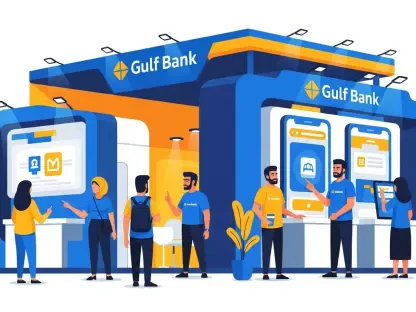Digital banking has reshaped the financial landscape in Singapore, delivering unmatched convenience and cutting-edge services to millions of users, but beneath this innovation lies a troubling reality: a dramatic spike in fraud and scam claims targeting these online-only platforms. Recent reports reveal a staggering increase, with claims jumping from just 42 throughout 2024 to 94 in the first eight months of the current year, resulting in losses of $2.5 million. This alarming trend casts a spotlight on the vulnerabilities inherent in a fully virtual banking model, where the absence of physical branches and face-to-face interactions may leave customers more exposed to deception. As digital banks grow in popularity among both retail and business clients, they’ve become prime targets for increasingly sophisticated criminals. This article delves into the driving forces behind this surge, examines the cunning tactics employed by scammers, and explores the multifaceted responses from banks and regulators to curb these threats.
Unpacking the Scale of the Fraud Crisis
The numbers paint a grim picture of the escalating fraud problem within Singapore’s digital banking sector. According to data from the Financial Industry Disputes Resolution Centre (Fidrec), fraud and scam claims against digital banks have risen sharply as a percentage of total claims against financial institutions, climbing to 8.7% by August of this year, up from a mere 2.1% two years prior. While these figures represent a small slice of overall claims, the rapid upward trajectory signals a growing threat as platforms like Trust Bank, GXS Bank, and MariBank attract a broader user base. Notably, a significant majority—84%—of these claims are tied to scams, with the remainder linked to disputes over service quality or bank policies. This concentration on fraudulent activities underscores the urgent need to address deceptive practices that exploit both technology and human trust, posing a serious challenge to the credibility and safety of digital banking as a whole.
Beyond the raw statistics, the nature of these scams reveals a calculated approach by fraudsters to maximize their impact. Predominantly, the methods involve compromised credentials through phishing attacks or malware infections, alongside impersonation schemes where scammers pose as trusted authorities or individuals to coax victims into transferring funds. These tactics are designed to exploit vulnerabilities in both digital systems and human behavior, often catching users off guard during moments of distraction or emotional strain. The sophistication of these attacks is further heightened by emerging technologies like artificial intelligence and deepfakes, which blur the lines between legitimate and fraudulent communications. As digital banks continue to onboard new customers, the increasing prevalence of such scams highlights a critical need for enhanced security measures and greater public awareness to combat these evolving threats.
Vulnerabilities in the Digital-Only Model
One of the core challenges facing digital banks in Singapore stems from their entirely online structure, which, while innovative, introduces unique risks. Without physical branches, there’s no opportunity for direct, in-person interaction between customers and bank representatives, a gap that can make users more susceptible to online deception. Professor Jan Ondrus from Essec Business School points out that this lack of face-to-face engagement often leaves customers without a trusted point of contact to verify suspicious activities, amplifying their vulnerability to scams. Although digital banks offer the allure of seamless, round-the-clock access, this convenience comes at the cost of reduced human oversight, creating an environment where fraudsters can operate with greater ease and anonymity compared to traditional banking setups that blend physical and digital touchpoints.
However, it’s worth noting that the risks are not exclusive to digital-only institutions. Experts emphasize that traditional banks, despite having physical locations, are equally exposed to online fraud since most transactions across the industry now occur digitally. The reality is that the majority of banking interactions—whether with a digital or conventional bank—happen through apps and websites, leveling the playing field for scammers who exploit these channels indiscriminately. This shared digital landscape means that vulnerabilities in cybersecurity and customer education are universal concerns, transcending the operational model of any single type of bank. As fraudsters adapt to target users regardless of the platform, the focus must shift toward strengthening online defenses and fostering a culture of vigilance among all banking customers to mitigate these pervasive risks.
How Scammers Exploit Human Weakness
Beyond technological exploits, the psychological tactics employed by scammers play a pivotal role in the rising fraud claims against digital banks. Fraudsters often target individuals at their most vulnerable, leveraging emotions like fear, urgency, or trust to manipulate them into making hasty decisions. Whether posing as a bank official warning of an account breach or creating a sense of panic over a supposed financial emergency, these criminals are adept at bypassing rational thinking. Ashley Millar from Trend Micro notes that such strategies are particularly effective during moments of stress or fatigue, when people are less likely to question the legitimacy of a request. This human element remains a critical weak spot, often proving more difficult to address than technical vulnerabilities in banking systems.
Moreover, the evolving sophistication of scams adds another layer of complexity to this issue. Scammers increasingly use tailored approaches, crafting messages or calls that appear convincingly authentic, often mimicking the tone and branding of legitimate institutions. The integration of advanced tools like AI-generated voices or deepfake visuals further erodes the ability of users to distinguish between real and fraudulent communications. This calculated exploitation of trust and technology means that even tech-savvy individuals can fall prey to these schemes if caught off guard. Addressing this challenge requires not just robust security protocols but also a concerted effort to educate customers on recognizing red flags, such as unsolicited requests for personal information or pressure to act immediately on financial transactions.
Technological Defenses by Digital Banks
In response to the mounting fraud crisis, digital banks in Singapore are harnessing their modern technological infrastructure to deploy proactive countermeasures. Unlike traditional banks burdened by legacy systems, digital platforms can swiftly implement features like real-time fraud alerts, 24/7 customer support hotlines, and pop-up warnings that appear before transactions are completed. Innovations such as “money lock” options, which restrict certain funds from being transferred, and “speed bumps”—thought-provoking prompts that encourage users to reconsider suspicious actions—have shown promising results. Banks like GXS Bank and MariBank report instances where customers have avoided scams after being prompted to pause and reflect, demonstrating the potential of these tools to interrupt fraudsters’ momentum.
Additionally, the agility of digital banks allows for continuous updates to their security frameworks, adapting to emerging threats with remarkable speed. For instance, algorithms designed to detect unusual transaction patterns can flag potential scams before they escalate, notifying users instantly via app notifications or text messages. Customer education is also embedded into these systems, with in-app tips and alerts guiding users on safe banking practices. While these technological interventions are not foolproof, they represent a significant step forward in creating a safer digital banking environment. The challenge lies in ensuring that such measures remain user-friendly, avoiding overly complex processes that might deter customers from engaging with these protective features, while still providing a strong barrier against increasingly cunning fraudulent activities.
Collaborative and Regulatory Efforts
The fight against fraud in digital banking extends beyond individual institutions to encompass broader industry and regulatory initiatives. Frameworks like the Shared Responsibility Framework and the Protection from Scams Act have been introduced to clearly define the roles of banks, telecommunications companies, and consumers in preventing scams, particularly phishing attacks. Recent policies, such as a mandatory 24-hour cooling period for large fund transfers, aim to safeguard customer assets by allowing time for reflection or intervention. While these measures offer a critical safety net, they have also sparked debate among users who find the delays inconvenient, especially for urgent financial needs, highlighting the tension between protection and practicality in regulatory design.
Collaboration is another cornerstone of the anti-fraud strategy, with entities like the Singapore Police Force’s Anti-Scam Centre playing a pivotal role. This hub brings together representatives from major banks, including GXS Bank, to facilitate rapid responses such as freezing compromised accounts and recovering stolen funds. Information sharing among financial institutions, as advocated by Christophe Barel from the Financial Services Information Sharing and Analysis Centre (FS-ISAC), further strengthens collective defenses by enabling banks to learn from each other’s encounters with emerging threats. These joint efforts underscore the importance of a united front in tackling scams, ensuring that no single entity bears the burden alone. As fraudsters grow more sophisticated, such partnerships will be vital in staying ahead of tactics that exploit both technological and human vulnerabilities.
Striking a Balance Between Safety and Usability
One of the most pressing dilemmas for digital banks is finding equilibrium between robust security and a seamless user experience. Enhanced safeguards, such as additional verification steps or transaction delays, are essential for protecting customer funds, as emphasized by representatives from institutions like MariBank and GXS Bank. However, these measures can introduce friction, slowing down processes that users expect to be instantaneous. For instance, a business owner named Mr. Tay expressed frustration over delays in transferring substantial sums for operational needs, suggesting that such policies can hinder critical financial agility. This sentiment reflects a broader challenge for digital banks to design protective mechanisms that do not alienate or inconvenience their customer base.
On the other hand, many users acknowledge the necessity of these trade-offs, prioritizing safety over speed. Individuals like Mr. Alvin Chow and Mr. Sam Chang have adapted their banking habits to comply with security thresholds, sometimes opting for alternative platforms for larger transactions. This diversity in customer perspectives illustrates the difficulty of crafting a one-size-fits-all solution in digital banking. Banks must navigate this delicate balance by tailoring security features to different user needs while maintaining accessibility. Innovative approaches, such as customizable security settings or opt-out options with clear disclaimers, could offer a middle ground, ensuring that protection does not come at the expense of user trust or satisfaction in the long term.
Future Pathways to Combat Digital Fraud
Reflecting on the surge in fraud claims, it’s evident that Singapore’s digital banking sector faced significant challenges in the recent past, and the sharp rise in incidents, with losses amounting to millions, exposed critical gaps in both technology and human preparedness. Digital banks, regulators, and industry partners took decisive steps to counter these threats, implementing real-time monitoring, transaction safeguards, and collaborative anti-scam initiatives. These efforts marked a turning point in addressing the vulnerabilities of an online-only financial ecosystem, even as scammers adapted with increasingly sophisticated methods like AI-driven deception.
Looking ahead, the path to a safer digital banking landscape demands ongoing innovation and vigilance. Strengthening customer education on recognizing phishing attempts and suspicious communications should remain a priority, empowering users to act as the first line of defense. Digital banks must continue refining their technological tools, ensuring they evolve faster than the tactics of fraudsters. Regulatory bodies and collaborative centers should expand their reach, fostering even tighter integration among stakeholders to preempt emerging risks. Ultimately, sustained investment in both systemic solutions and individual awareness will be crucial to safeguarding the future of digital finance against the persistent shadow of fraud.









